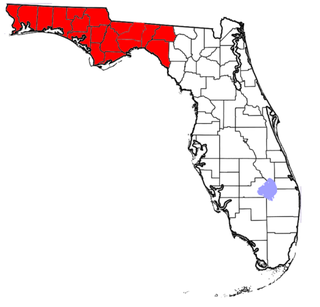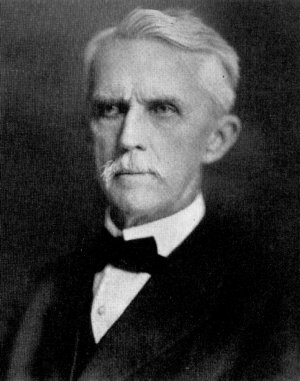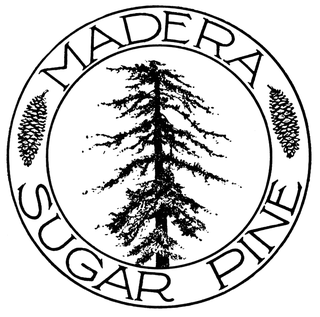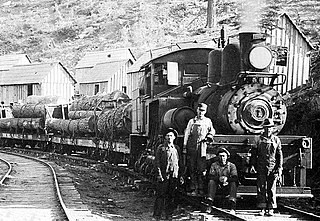
Caryville is a town in Washington County, Florida, United States located along the Choctawhatchee River. The Caryville is part of the Florida Panhandle in North Florida. The population was 301 at the 2020 census, down from 411 at the 2010 census. It is part of the Panama City—Panama City Beach, Florida Metropolitan Statistical Area.

The Florida panhandle is the northwestern part of the U.S. state of Florida. It is a salient roughly 200 miles (320 km) long, bordered by Alabama on the north and the west, Georgia on the north, and the Gulf of Mexico to the south. Its eastern boundary is arbitrarily defined. It is defined by its southern culture and rural geography relative to the rest of Florida, as well as closer cultural links to French-influenced Louisiana, Mississippi, and Alabama. Its major communities include Pensacola, Navarre, Destin, Panama City Beach, and Tallahassee.

The Alabama & Gulf Coast Railway is a Class II railroad owned by Genesee & Wyoming. It operates 339 miles (546 km) of track from the Pensacola, Florida export terminals, west of downtown, north to Columbus, Mississippi, with trackage rights along BNSF Railway to Amory, Mississippi. A branch uses trackage rights along Norfolk Southern from Kimbrough, Alabama west and south to Mobile, Alabama, with separate trackage at the end of the line in Mobile.
The Babcock Lumber Company was founded in Pittsburgh, Pennsylvania in 1887 and conducted logging operations in the eastern United States. In 1951 the company diversified into building material distribution. Today the company has two main divisions: hardwood lumber manufacturing and wholesale building material distribution.

Philip Keyes Yonge, usually given as P. K. Yonge, was a businessman and civic leader. A resident of Pensacola, he was a prominent Floridian. A founding member of the Florida Board of Control, he served on that board for almost 30 years as a member and chairman. The P.K. Yonge Developmental Research School in Gainesville is named for him.

The Pennsylvania Lumber Museum is near Galeton, Potter County, Pennsylvania in the United States. It documents the history and technology of the lumber industry that was a vital part of the economic development and ecological destruction of Pennsylvania.
The Great Southern Lumber Company was chartered in 1902 to harvest and market the virgin longleaf pine forests in southeastern Louisiana and southwestern Mississippi. Bogalusa, Louisiana was developed from the ground up as a company town and was the location for Great Southern Lumber Company's sawmill, which began operation in 1908. Other company interests included a railroad and paper mill. The company ceased operation in 1938, when the supply of virgin pines was depleted. Bogalusa became the site of a paper mill and chemical operations, followed by other industry.
The Finkbine-Guild Lumber Company was established to harvest and market the virgin longleaf pine stands of southern Mississippi during the early 20th century. The main sawmills were located in Wiggins and D'Lo, Mississippi. When the local timber supply dwindled, the company tried to utilize redwood trees from California, but that operation failed because of high transportation costs. Other attempts were made at promoting a more diversified use of the cutover timberlands; some ventures were successful while others were not.

The forests in the U.S. state of Texas have been an important resource since its earliest days and have played a major role in the state's history. The vast woodlands of the region, home to many varieties of wildlife before Europeans first showed up, provided economic opportunities for early settlers. They continue to play an important role economically and environmentally in the state.

The Gulf and Ship Island Railroad (G&SI) was constructed in the state of Mississippi, USA, at the turn of the 20th century to open a vast expanse of southern yellow pine forests for commercial harvest. In spite of economic uncertainty, entrepreneurs William H. Hardy and Joseph T. Jones successfully completed railroad construction. The railroad resulted in the development of a seaport and expansion of cities along its route.

Pine Creek Gorge, sometimes called The Grand Canyon of Pennsylvania, is a 47-mile (76 km) gorge carved into the Allegheny Plateau by Pine Creek in north-central Pennsylvania.

The Oregon and Northwestern Railroad (O&NW) is a defunct railroad in eastern Oregon in the United States. It ran 50.2 miles (80.8 km) from Hines north to Seneca, which is on the edge of the Malheur National Forest, over a total of 19 trestles.
L.N. Dantzler Lumber Company began as a small sawmill owned by William Griffin in Moss Point, Mississippi. L.N. Danzler bought it in the 1870s and, with two sons, incorporated the business in 1888. Originally, the main business was the manufacture of lumber from southern yellow pine, but in 1949, the company switched to tree farming of southern pines and sold timber by selective cutting to yield a variety of wood products. The family-owned business prospered for 75 years but was sold to International Paper Company in 1966.
Hybart is an unincorporated community in Monroe County, in the U.S. state of Alabama. Hybart is located at 31°49′36″N87°22′56″W. It is located at the intersection of Alabama State Route 41 and Monroe County Road 56, in the northwestern part of Monroe County, just a short distance from its border with Wilcox County, Alabama. Hybart is the host of a locally famous Alabama turkey hunting competition called the Butterball which has appeared in Mobile Bay Magazine. The area is also known for being a good hunting spot for whitetail deer, turkey, quail, dove, and duck. Hybart is on the northwestern edge of the Red Hills region of southwestern Alabama, a hilly, wooded, and still largely undeveloped part of the state, geologically distinct from the Gulf Coastal Plain to its south, and the Black Belt region to its north. Within the Red Hills region, the Forever Wild Land Trust of Alabama owns two large tracts of land a few miles to the southeast of Hybart. Recreational opportunities in these tracts include hunting, woods road hiking/exploration, wildflower viewing, photography, and bird and wildlife watching. The Red Hills tracts are open to visitors year-round.

Millview is an unincorporated community located along Perdido Bay in Escambia County, Florida, United States.

The Madera Sugar Pine Company was a United States lumber company that operated in the Sierra Nevada region of California during the late 19th and early 20th centuries. The company distinguished itself through the use of innovative technologies, including the southern Sierra's first log flume and logging railroad, along with the early adoption of the Steam Donkey engine. Its significant regional impact led to the establishment of towns such as Madera, Fish Camp, and Sugar Pine, as well as the growth of Fresno Flats and the formation of Madera County.

The Sugar Pine Lumber Company was an early 20th century logging operation and railroad in the Sierra Nevada. Unable to secure water rights to build a log flume, the company operated the “crookedest railroad ever built." They later developed the Minarets-type locomotive, the largest and most powerful saddle tank locomotive ever made. The company was also a pioneer in the electrification of logging where newly plentiful hydroelectric power replaced the widespread use of steam engines.

The Yosemite Lumber Company was an early 20th century Sugar Pine and White Pine logging operation in the Sierra Nevada. The company built the steepest logging incline ever, a 3,100 feet (940 m) route that tied the high-country timber tracts in Yosemite National Park to the low-lying Yosemite Valley Railroad running alongside the Merced River. From there, the logs went by rail to the company’s sawmill at Merced Falls, about fifty-four miles west of El Portal.















